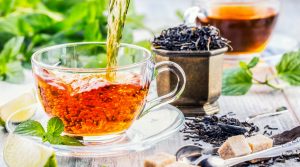A cup of “Irish breakfast tea” would be a perfect way to start the day with. Have you ever wondered where it comes from? It is made from small-sized Assam tea leaves which is a type of black tea grown in the region of Assam, the largest tea-growing region along the mighty river the Brahmaputra and bordering Bangladesh and Myanmar, from the plant Camellia sinensis.
Assam Tea
Black tea distinguishes itself from other types of tea by its dark leaves and more intense flavor caused due to oxidation. This gives the Assam tea a malty flavor, enormous aroma, bright color and energetic taste.
Robert Bruce, a Scottish adventurer introduced tea bushes from Assam in Europe in the year 1823. During the East India Company, a committee was constructed in 1834 to evaluate the scientific nature and mercantile potential of Assam tea.
The “Tea committee” discovered that a hybrid of the Chinese and Assam tea would be best suited in the climate and topography of Assam. Assam experiences precipitation of 10-12 inches in the monsoon per day and the temperature rises to 96.8F which is extremely humid and hot.
This tropical climate contributes to the aroma and taste which makes this tea significant. The planting and manufacture of Assam tea from 1840 to 1860 were monopolised by the Assam Company, which operated through the labor of the local Kachari community.
The success of the company and the colonial policy to offer land for the tea plantation led to a revolution in the production of tea in Assam in the 1860’s. Most of the tea estates in Assam are the members of the Assam Branch of the Indian Tea Association, which is the senior and most eminent body of tea manufacturers of India.
Assam tea is harvested twice and commonly called the “first flush’” and the “second flush”. The “second flush” produces the highly-priced “tippy tea” which is plucked from the gold tips and is sweeter and full-bodied and costs more than the “first flush” harvest.
There are two to seven stages in the processing of tea leaves and any change might result in a different type of tea. Moisture and temperature can affect the tea production and thus the procedure is carried out in a climate-controlled facility. Withering, fixing, oxidation, rolling, drying and aging are the major steps involved.
The interesting fact about the tea plantations is that it doesn’t follow the IST(Indian Standard Time) and has a separate timezone called “Tea Garden Time” or Bagan Time, which is one hour ahead of IST.
Assam tea is known to have higher caffeine content than other teas which is about 50-90mgs of caffeine per cup. However, a stronger and darker brew will yield more caffeine. The most likely Assam tea benefits that you’ll experience is a boost in energy and an increase in mental alertness from the caffeine which is enjoyed by drinkers in the morning.
In addition, black tea contains polyphenols including catechins, flavonoids, and tannins which is known to boost your health. It is also said to have the property to reduce cancer but is yet to be proven scientifically. To take the full advantage of black tea, people use loose leaves without sugar or milk.
It also has proved to have side effects like increased heartbeat, palpitations, restlessness, nervousness, problems with sleep, or a headache. Some people may even experience nausea, vomiting, diarrhea, and diuresis. However, the celebrated Assam tea continues to be produced approximately 1500 million pounds of tea every year.



